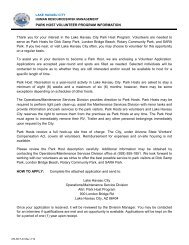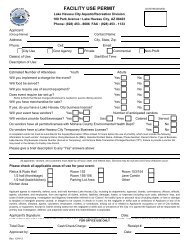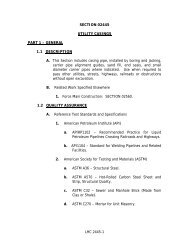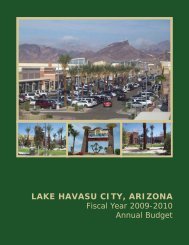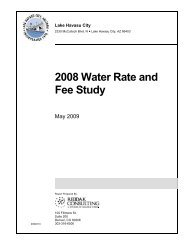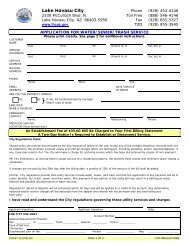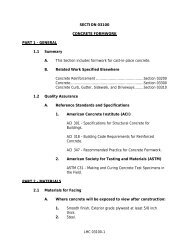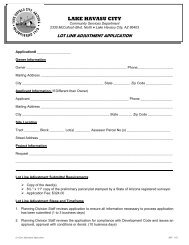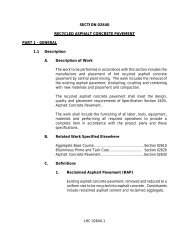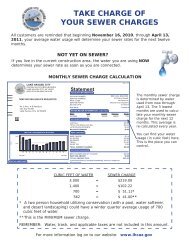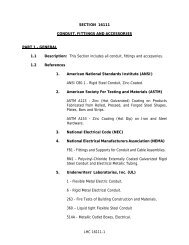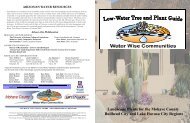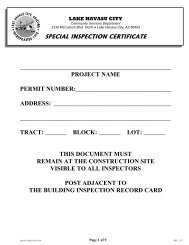Water Quality Report - Lake Havasu City
Water Quality Report - Lake Havasu City
Water Quality Report - Lake Havasu City
You also want an ePaper? Increase the reach of your titles
YUMPU automatically turns print PDFs into web optimized ePapers that Google loves.
LAKE HAVASU CITY<br />
ARIZONA<br />
Annual Drinking <strong>Water</strong> <strong>Quality</strong> <strong>Report</strong><br />
For 2013<br />
Published June 24, 2014<br />
for<br />
LAKE HAVASU CITY SYSTEM I.D. #04-08022<br />
Este reporte contiene información importante sobre su agua<br />
para tomar. Si no entiende ingles, por favor busque a<br />
alguien que le translada el reporte y le explique la<br />
información a usted.<br />
The annual Consumer Confidence <strong>Report</strong> is mandated by the<br />
United States Environmental Protection Agency (EPA), as a<br />
means of sharing information with residents regarding <strong>Lake</strong><br />
<strong>Havasu</strong> <strong>City</strong>’s water quality. This report is designed to give<br />
you, the consumer, all pertinent information relative to the<br />
production and distribution of safe drinking water for <strong>Lake</strong><br />
<strong>Havasu</strong> <strong>City</strong>. Currently the city utilizes as the primary source<br />
of drinking water the horizontal collector well that is capable<br />
of producing 24 million gallons a day (mgd). Nine of the<br />
city’s original wells used prior to the collector well are now<br />
maintained as a backup supply capable of producing 20 mgd.<br />
The groundwater supply draws water from the Colorado River<br />
aquifer with an annual allocation of 28,139 acre-feet or 8.9<br />
billion gallons of water a year. <strong>Lake</strong> <strong>Havasu</strong> <strong>City</strong> distributes<br />
its water through 483 miles of water distribution lines ranging<br />
from 4-inches to 36-inches in diameter serving just over<br />
33,000 residential and commercial water services. Twentyfive<br />
water tanks totaling 20.5 million gallons of water storage<br />
serve the city’s seven pressure zones.<br />
Sources of drinking water (both tap and bottled water) include<br />
rivers, lakes, streams, ponds, reservoirs, springs, and wells. As<br />
water travels over the surface of the land or through the<br />
ground it dissolves naturally occurring minerals, and in some<br />
cases radioactive material and can pick up substances resulting<br />
from the presence of animals or from human activity.<br />
Contaminants that may be present in source water include the<br />
following: (A) Microbial contaminants such as viruses and<br />
bacteria that may be from sewage treatment plants, septic<br />
systems, agricultural livestock operations, or wildlife; (B)<br />
Inorganic contaminants such as salts and metals that can be<br />
naturally occurring or result from urban storm water runoff,<br />
industrial or domestic wastewater discharges, oil and gas<br />
production, mining, or farming; (C) Pesticides and herbicides<br />
that may come from a variety of sources such as agriculture,<br />
urban storm water runoff, and residential uses; (D) Organic<br />
chemical contaminants including synthetic and volatile<br />
organic chemicals that are by-products of industrial processes<br />
and petroleum production, and can also come from gas<br />
stations, urban storm water runoff, and septic systems; and (E)<br />
Radioactive contaminants that can be naturally occurring or<br />
can be the result of oil and gas production and mining<br />
activities.<br />
To ensure that tap water is safe to drink, the Arizona<br />
Department of Environmental <strong>Quality</strong> prescribes regulations<br />
that limit the amount of certain contaminants in water<br />
provided by public water systems. The United States Food and<br />
Drug Administration regulations establish limits for<br />
contaminants in bottled water that must provide the same<br />
protection for public health.<br />
Drinking water, including bottled water, may reasonably be<br />
expected to contain at least small amounts of some<br />
contaminants. The presence of contaminants does not<br />
necessarily indicate that water poses a health risk. Some<br />
people may be more vulnerable to contaminants in drinking<br />
water than the general population. Immuno-compromised<br />
persons such as persons with cancer undergoing<br />
chemotherapy, persons who have undergone organ transplants,<br />
persons with HIV, AIDS, or other immune system disorders,<br />
some elderly, and infants can be particularly at risk from<br />
infections. These people should seek advice about drinking<br />
water from their health care providers. The United States<br />
Environmental Protection Agency and Centers for Disease<br />
Control guidelines on appropriate means to lessen the risk of<br />
infection by Cryptosporidium and other microbial<br />
contaminants as well as more information about contaminants<br />
in tap water and potential health effects can be obtained by<br />
calling the Environmental Protection Agency’s Safe Drinking<br />
<strong>Water</strong> Hotline at 800-426-4791. Information on bottled water<br />
can be obtained from the United States Food and Drug<br />
Administration.<br />
If a contaminant in sampled water is found to be out of<br />
compliance with drinking water standards, <strong>Lake</strong> <strong>Havasu</strong> <strong>City</strong><br />
is required by state and federal regulations to notify customers<br />
by letter or through the media of the affected service area(s). If<br />
a serious situation occurs that may affect the health and wellbeing<br />
of residents, <strong>Lake</strong> <strong>Havasu</strong> <strong>City</strong> will do whatever is<br />
necessary to warn customers and to find an alternate source of<br />
drinking water.<br />
WATER TREATMENT PLANT<br />
<strong>Lake</strong> <strong>Havasu</strong> <strong>City</strong>’s water treatment plant is designed for a<br />
production capability of up to 26 mgd. <strong>Water</strong> was produced at<br />
an average of 10.58 million gallons per day in 2013 to satisfy<br />
the city’s potable water needs. The plant is designed primarily<br />
to remove manganese from <strong>Lake</strong> <strong>Havasu</strong> <strong>City</strong>’s drinking<br />
water supply and to reduce arsenic levels to meet the EPA<br />
established MCL standard of 10 ppb (ug/L). We are happy to<br />
report that manganese is reduced to a virtual “non-detect”<br />
level, with the treatment process removing approximately<br />
271,020 pounds of manganese sludge from the city’s water in<br />
2013. The treatment process lowers arsenic levels well under<br />
the federal standard.<br />
WATER SAMPLING<br />
Contaminants in your drinking water are routinely monitored<br />
according to Federal and State laws. The State of Arizona<br />
requires monitoring for certain contaminants less than once<br />
per year because the concentrations of these contaminants are<br />
not expected to vary significantly from year to year, or the<br />
system is not considered vulnerable to this type of<br />
contamination. Some of our data, though representative, may<br />
be more than one year old.
We are pleased to report that <strong>Lake</strong> <strong>Havasu</strong> <strong>City</strong>’s drinking water sampled for potential contaminants consistently<br />
tested well below the maximum allowable levels for all regulated contaminants.<br />
HEALTH EFFECTS INFORMATION ABOUT THE<br />
FOLLOWING TABLES<br />
Nitrate in drinking water at levels above 10 ppm is a health<br />
risk for infants of less than six months of age. High nitrate<br />
levels in drinking water can cause blue baby syndrome.<br />
Nitrate levels may rise quickly for short periods-of-time<br />
because of rainfall or agricultural activity. If you are caring<br />
for an infant, and detected nitrate levels are above 5 ppm, you<br />
should ask advice from your health care provider.<br />
If arsenic is less than the MCL, your drinking water meets<br />
EPA’s standards. EPA’s standard balances the current<br />
understanding of arsenic’s possible health effects against the<br />
costs of removing arsenic from drinking water. EPA<br />
continues to research the health effects of low levels of<br />
arsenic, which is a mineral known to cause cancer in humans<br />
at high concentrations and is linked to other health effects<br />
such as skin damage and circulatory problems.<br />
Infants and young children are typically more vulnerable to<br />
lead in drinking water than the general population. It is<br />
possible that lead levels at your home may be higher than at<br />
other homes in the community as a result of materials used in<br />
your home’s plumbing. If you are concerned about elevated<br />
lead levels in your home’s water, you may wish to have your<br />
water tested. Flush your tap for 30 seconds to 2 minutes<br />
before using tap water. Additional information is available<br />
from the EPA Safe Drinking <strong>Water</strong> Hotline at<br />
1-800-426-4791.<br />
SOURCE WATER ASSESSMENT (HIGH RISK)<br />
The following classification does not imply that the source<br />
water is contaminated nor does it mean that contamination is<br />
imminent. Rather, it simply states that land use activities or<br />
hydrogeologic conditions exist that make the source water<br />
susceptible to possible future contamination. Based on the<br />
information currently available on the hydrogeologic settings<br />
and the adjacent land uses that are in the specified proximity<br />
of the drinking water source(s) of this public water system, the<br />
Arizona Department of Environmental <strong>Quality</strong> (ADEQ) has<br />
given a high risk designation for the degree to which this<br />
drinking water source(s) are protected. A designation of high<br />
risk indicates there may be additional source water protection<br />
measures which can be implemented on the local level.<br />
TERMS & DEFINITIONS<br />
Parts per million (ppm) or Milligrams per liter (mg/L) –<br />
One part per million corresponds to one minute in two years or a<br />
single penny in $10,000.<br />
Parts per billion (ppb) or Micrograms per liter (µg/L) - One<br />
part per billion corresponds to one minute in 2,000 years, or a<br />
single penny in $10,000,000.<br />
Picocuries per liter (pCi/L) - Picocuries per liter is a measure<br />
of the radioactivity in water.<br />
Action Level (AL) - the concentration of a contaminant which,<br />
if exceeded, triggers treatment or other requirements which a<br />
water system must follow.<br />
Action Level Goal (ALG) - The “Goal” is the level of a<br />
contaminant in drinking water below which there is no known or<br />
expected risk to health. The ALG allows for a margin of safety.<br />
Treatment Technique (TT) - A treatment technique is a<br />
required process intended to reduce the level of a contaminant in<br />
drinking water.<br />
Maximum Contaminant Level Goal (MCLG) - The “Goal” is<br />
the level of a contaminant in drinking water below which there is<br />
no known or expected risk to health. MCLGs allow for a margin<br />
of safety.<br />
Maximum Contaminant Level (MCL) - The “Maximum<br />
Allowed” is the highest level of a contaminant that is allowed in<br />
drinking water. MCLs are set as close to the MCLGs as feasible<br />
using the best available treatment technology.<br />
Maximum Residual Disinfectant Level Goal (MRDLG): The<br />
level of a drinking water disinfectant, below which there is no<br />
known or expected risk to health. MRDLGs do not reflect the<br />
benefits of the use of disinfectants to control microbial<br />
contaminants.<br />
Maximum Residual Disinfectant Level (MRDL): The highest<br />
level of a disinfectant allowed in drinking water. There is<br />
convincing evidence that addition of a disinfectant is necessary<br />
for control of microbial contaminants.<br />
Running Annual Average (RAA): An average of monitoring<br />
results for the previous 12 calendar months.<br />
These tables show the results of our monitoring for the period of January 1 to December 31, 2013 unless otherwise noted.<br />
Microbiological Contaminants<br />
Contaminant MCL MCLG Unit Result<br />
Total Coliform Bacteria for<br />
Systems that collect 40><br />
samples per month<br />
No more than 5% of monthly<br />
samples can be positive<br />
0<br />
Absent or<br />
Present<br />
0<br />
Absent<br />
Violation<br />
(Yes or No)<br />
Sample<br />
Date<br />
No 2013<br />
Likely Source of<br />
Contamination<br />
Naturally present<br />
in the environment
Radionuclides<br />
Contaminant MCL MCLG Units Level Detected<br />
Violation<br />
(Yes or No)<br />
Sample<br />
Date<br />
Likely Source of Contamination<br />
Alpha emitters (pCi/L) 15 0 pCi/L 6.39 ± 3.31 No May 2011 Erosion of natural deposits<br />
Combined Radium 226 &<br />
228 (pCi/L)<br />
5 0 pCi/L 2.87±0.64 No May 2011 Erosion of natural deposits<br />
Uranium (pCi/L) 30 0 pCi/L 7.31 ± 0.086 No May 2011 Erosion of natural deposits<br />
Lead and Copper<br />
Contaminant AL ALG Units<br />
90 th<br />
Percentile<br />
Number<br />
of Sites<br />
over AL<br />
Violation<br />
(Yes or No)<br />
Sample<br />
Date/Year<br />
Copper 1.3 1.3 ppm 0.46 0 No 8-2011<br />
Lead 15 0 ppb 6.72 0 No 8-2011<br />
Likely Source of Contamination<br />
Corrosion of household plumbing systems;<br />
erosion of natural deposits; leaching from<br />
wood preservatives<br />
Corrosion of household plumbing systems,<br />
erosion of natural deposits<br />
Disinfectants<br />
Level<br />
Violation Sample<br />
Contaminant MRDL MRDLG Units Detected & Range (Yes or No) Date/Year Source<br />
Chlorine 4 4 ppm 0.63; 0.01 to 1.63 No RAA/2013 <strong>Water</strong> additive used to control microbes<br />
Contaminant MCL MCLG Units Average<br />
Halo acetic Acids<br />
(HAA5)<br />
Total<br />
Trihalomethanes<br />
(TTHM)<br />
Disinfection Byproducts<br />
Range Detected<br />
Highest RAA<br />
Violation<br />
(Yes or No)<br />
Sample<br />
Date/Year<br />
60 N/A ppb 13 11 to 15 13 No 2013<br />
80 N/A ppb 68 64 to 73 68 No 2013<br />
Likely Source of<br />
Contamination<br />
By-product of<br />
drinking water<br />
disinfection<br />
By-product of<br />
drinking water<br />
disinfection<br />
Contaminant MCL MCLG Units<br />
Arsenic 10 0 ppb<br />
Inorganic Contaminants<br />
Level<br />
Detected/Range<br />
4.8<br />
3.0 to 6.1<br />
Violation<br />
(Yes or No)<br />
Sample<br />
Date/Year<br />
No 2013<br />
Barium 2 2 ppm 0.044 No 11-27-2012<br />
Fluoride 4 4 ppm 0.61 No 11-27-2012<br />
Nitrate (as Nitrogen) 10 10 ppm 1.0 No 12-18-2013<br />
Likely Source of Contamination<br />
Erosion of natural deposits; runoff from<br />
orchards; runoff from glass and electronics<br />
production wastes<br />
Discharge of drilling wastes; discharge<br />
from metal refineries; erosion of natural<br />
deposits<br />
Erosion of natural deposits; water additive<br />
which promotes strong teeth; discharge<br />
from fertilizer and aluminum factories<br />
Runoff from fertilizer use; leaching from<br />
septic tanks, sewage; erosion of natural<br />
deposits<br />
Stage 2 Disinfectants and Disinfection By-Products Rule<br />
Stage 2 DBP Rule required some systems to complete an Initial Distribution System Evaluation (IDSE) to characterize DBP levels in their<br />
distribution systems and identify locations to monitor DBPs for Stage 2 DBP Rule compliance. The following table summarizes the individual<br />
sample results for the IDSE standard monitoring performed in 2013<br />
Contaminant<br />
Number of<br />
Analyses<br />
Minimum Level<br />
Detected<br />
Highest Level<br />
Detected<br />
Haloacetic Acids (HAA5) (ppb) 14 5.7 17<br />
Total Trihalomethanes (TTHM) (ppb) 14 32 96
<strong>Lake</strong> <strong>Havasu</strong> <strong>City</strong>’s drinking water is in compliance with all state and federal drinking water standards.<br />
LAKE HAVASU CITY<br />
Operations – <strong>Water</strong> Division<br />
900 London Bridge Road<br />
<strong>Lake</strong> <strong>Havasu</strong> <strong>City</strong>, AZ 86404<br />
PRST<br />
STD<br />
U.S. POSTAGE PAID<br />
LAKE HAVASU CITY, AZ<br />
PERMIT#<br />
POSTAL CUSTOMER<br />
<strong>Lake</strong> <strong>Havasu</strong> <strong>City</strong>, AZ<br />
LAKE HAVASU CITY, ARIZONA<br />
Annual Drinking <strong>Water</strong> <strong>Quality</strong> <strong>Report</strong> For 2013<br />
LAKE HAVASU CITY MEETS SAFE DRINKING WATER STANDARDS<br />
Este reporte contiene información importante sobre su agua para tomar. Si no entiende ingles, por favor busque a<br />
alguien que le translada el reporte y le explique la información a usted.<br />
<strong>Lake</strong> <strong>Havasu</strong> <strong>City</strong> residents concerned about the quality of water in <strong>Lake</strong> <strong>Havasu</strong> <strong>City</strong>, or with questions regarding the<br />
information contained in this report, may contact the Utility Supervisor Doug Foster or Division Manager Chuck Michalski at<br />
the <strong>Lake</strong> <strong>Havasu</strong> <strong>City</strong> <strong>Water</strong> Division, (928) 855-2618.<br />
All water consumers may learn more about the <strong>City</strong>’s efforts to provide safe drinking water by attending the regularly<br />
scheduled <strong>City</strong> Council meetings when water issues or projects are included on the agenda. The <strong>City</strong> Council meets each<br />
month on the second and fourth Tuesday, at 6 p.m., at the <strong>Lake</strong> <strong>Havasu</strong> <strong>City</strong> Police Facility, 2360 McCulloch Boulevard.<br />
Agendas for these meetings are posted at city hall, the post office, the police facility, and in the local newspaper.<br />
This report may also be reviewed on the city’s web site: www.lhcaz.gov<br />
NEXT REPORT ON SAFE DRINKING WATER: JUNE 30, 2015



